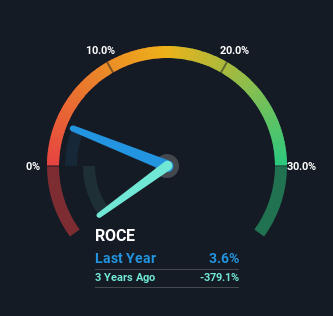- Australia
- /
- Oil and Gas
- /
- ASX:HHR
There's Been No Shortage Of Growth Recently For Hartshead Resources' (ASX:HHR) Returns On Capital

What are the early trends we should look for to identify a stock that could multiply in value over the long term? Typically, we'll want to notice a trend of growing return on capital employed (ROCE) and alongside that, an expanding base of capital employed. Ultimately, this demonstrates that it's a business that is reinvesting profits at increasing rates of return. So on that note, Hartshead Resources (ASX:HHR) looks quite promising in regards to its trends of return on capital.
Return On Capital Employed (ROCE): What Is It?
For those that aren't sure what ROCE is, it measures the amount of pre-tax profits a company can generate from the capital employed in its business. To calculate this metric for Hartshead Resources, this is the formula:
Return on Capital Employed = Earnings Before Interest and Tax (EBIT) ÷ (Total Assets - Current Liabilities)
0.036 = AU$1.3m ÷ (AU$38m - AU$2.8m) (Based on the trailing twelve months to June 2023).
Thus, Hartshead Resources has an ROCE of 3.6%. Ultimately, that's a low return and it under-performs the Oil and Gas industry average of 16%.
View our latest analysis for Hartshead Resources

In the above chart we have measured Hartshead Resources' prior ROCE against its prior performance, but the future is arguably more important. If you'd like, you can check out the forecasts from the analysts covering Hartshead Resources here for free.
What The Trend Of ROCE Can Tell Us
We're delighted to see that Hartshead Resources is reaping rewards from its investments and is now generating some pre-tax profits. Shareholders would no doubt be pleased with this because the business was loss-making three years ago but is is now generating 3.6% on its capital. Not only that, but the company is utilizing 28,712% more capital than before, but that's to be expected from a company trying to break into profitability. This can tell us that the company has plenty of reinvestment opportunities that are able to generate higher returns.
In another part of our analysis, we noticed that the company's ratio of current liabilities to total assets decreased to 7.3%, which broadly means the business is relying less on its suppliers or short-term creditors to fund its operations. So this improvement in ROCE has come from the business' underlying economics, which is great to see.
The Bottom Line
To the delight of most shareholders, Hartshead Resources has now broken into profitability. Astute investors may have an opportunity here because the stock has declined 42% in the last year. That being the case, research into the company's current valuation metrics and future prospects seems fitting.
Since virtually every company faces some risks, it's worth knowing what they are, and we've spotted 3 warning signs for Hartshead Resources (of which 1 makes us a bit uncomfortable!) that you should know about.
If you want to search for solid companies with great earnings, check out this free list of companies with good balance sheets and impressive returns on equity.
Valuation is complex, but we're here to simplify it.
Discover if Hartshead Resources might be undervalued or overvalued with our detailed analysis, featuring fair value estimates, potential risks, dividends, insider trades, and its financial condition.
Access Free AnalysisHave feedback on this article? Concerned about the content? Get in touch with us directly. Alternatively, email editorial-team (at) simplywallst.com.
This article by Simply Wall St is general in nature. We provide commentary based on historical data and analyst forecasts only using an unbiased methodology and our articles are not intended to be financial advice. It does not constitute a recommendation to buy or sell any stock, and does not take account of your objectives, or your financial situation. We aim to bring you long-term focused analysis driven by fundamental data. Note that our analysis may not factor in the latest price-sensitive company announcements or qualitative material. Simply Wall St has no position in any stocks mentioned.
About ASX:HHR
Hartshead Resources
Engages in the exploration and development of oil and gas properties in the United Kingdom, Gabon, and Madagascar.
Flawless balance sheet low.
Market Insights
Community Narratives





